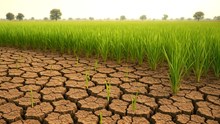
The undeniable influence of human activities on climate change has resulted in widespread and often irreversible alterations to the atmosphere, oceans, biosphere, and cryosphere. These changes, particularly in ocean dynamics, global sea levels, and ice sheet stability, pose severe long-term impacts. Currently, global warming affects approximately 80% of the world's land area, home to about 85% of the global population.
According to national climate action plans, global temperatures could exceed 2.7°C above pre-industrial levels by the end of the century unless significant reductions in greenhouse gas emissions are achieved. This escalation in temperature not only leads to extreme weather events but also significantly impacts the safety of our food supply, posing a critical challenge to global food security.
Climate Change and Food Safety
Extreme climate events are becoming more frequent and severe, impacting not only food security by reducing agricultural productivity but also food safety. Changes in temperature, precipitation patterns, soil quality, and sea levels directly affect the severity and distribution of biological and chemical contaminants in food, increasing the risk of foodborne hazards. The global food supply chain's rapid globalization further exacerbates this risk, enabling local foodborne incidents to escalate into international outbreaks.
Unsafe food is a critical concern, as sufficient, affordable, nutritious, and safe food is essential for food security. Climate change exacerbates food loss and contamination, complicating efforts to meet the growing global food demand. About 14% of food produced is lost during production due to contamination issues, a problem likely to worsen with climate change.
Specific Foodborne Hazards
1. Foodborne Pathogens
Rising temperatures and changing precipitation patterns are altering the geographic distribution and persistence of foodborne pathogens. Pathogens like Salmonella and Campylobacter have shown increased infection rates linked to higher temperatures. Severe weather events like hurricanes and floods further facilitate the spread of these pathogens in the food chain. Additionally, there is evidence that rising temperatures contribute to antimicrobial resistance in human pathogens, posing significant health risks.
2. Harmful Algal Blooms
The frequency and duration of harmful algal blooms are increasing due to eutrophication, intense precipitation, warmer temperatures, and ocean acidification. These blooms can create hypoxic zones, making aquatic life unsustainable and producing toxins that accumulate in seafood, leading to foodborne illnesses like ciguatera poisoning.
3. Mycotoxins
Mycotoxins are toxic compounds produced by fungi that contaminate crops. Climate change factors such as temperature, humidity, and pest damage influence fungal infections and mycotoxin production. As temperate zones become warmer, they become more suitable for agriculture and susceptible to fungal contamination. This has led to the spread of aflatoxins from traditionally tropical regions to temperate areas like the Mediterranean. Inadequate postharvest practices exacerbate this risk.
Addressing the Challenge
To ensure food safety amid growing climate change impacts, food supply chains and regulatory systems must be better prepared. Implementing widespread early warning systems, robust monitoring, and surveillance measures are crucial, particularly in climate-vulnerable countries. Effective information dissemination and transparency in data sharing are essential for preventing and controlling foodborne outbreaks.
Enhancing research capacity and funding in climate-vulnerable regions is vital to address the current "attribution gap." Integrating structured foresight systems would allow a proactive approach to food safety, identifying and addressing emerging concerns exacerbated by climate change. Digital innovations in traceability can help track and remove contaminated food products, maintaining food safety.
A multidisciplinary, unified response is necessary to tackle food safety challenges posed by climate change. This requires an integrated, cross-sectoral approach, engaging local, national, and global efforts across the environment, agriculture, and health sectors.
Climate change significantly impacts food safety by altering the occurrence and distribution of biological and chemical contaminants in food. Ensuring safe food in the face of climate change requires proactive measures, robust monitoring systems, and a unified, cross-sectoral response. Addressing these challenges is crucial for achieving food security and safeguarding public health in a rapidly changing climate.
















